Mesothelioma Stages

Progression of Mesothelioma has 4 Stages
Traditionally, these Mesothelioma stages measured only the tumor mass under the Butchart System. A second system, TNM system, looks at the growth of lymph nodes, which filter out harmful substances from the body, and metastasis, or the extent that the cancer has spread. Another system, called the Brigham System, focuses on surgical options and the extent that lymph nodes are affected. All staging systems relate to pleural (chest) mesothelioma, the most common form of the disease, and use four stages. There are no established staging systems for peritoneal or pericardial mesothelioma. The first two stages for Butchart and TNM are fairly similar.
Stage I
Cancer is limited to one side of the chest’s pleural lining.
The pleural lining is a wet, thin membrane between the lungs and the walls of the chest cavity. Its purpose is to protect the lungs from abrasion. There are two layers of this lining, or pleura: one that lines the lungs, and one that lines the chest wall. Under normal breathing, these linings easily slide over each other. When malignant mesothelioma develops in the lining (pleura), it thickens and can press on the lung. Fluid can accumulate between the pleura. At this point, there can be trouble breathing, chest pain, coughing, and hoarseness. The TNM staging system breaks down Stage I into two categories that describe where the cancer is located.
- Stage IA is when the cancer is found on one side of the chest in the chest wall lining. It also covers when it is found in the chest cavity lining between the lungs and/or the lining that covers the diaphragm. The cancer has not affected the lung.
- Stage IB is used when cancer is in the chest lining on one side of the chest and on the lining that covers the lung. It includes cancer in the linings of the chest cavity and/or diaphragm.
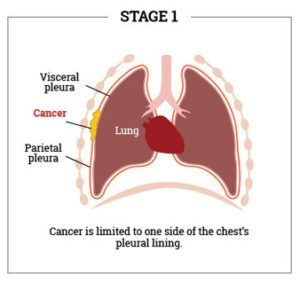
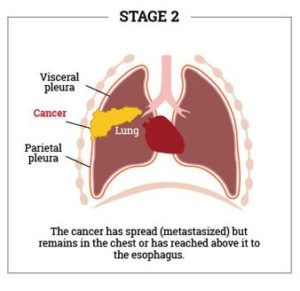
Stage II
The cancer has spread (metastasized).
However, the cancer remains in the chest or has reached above it to the esophagus.
-
The two systems have different definitions for Stages III and IV.
The tumor system, or Butchart System, defines Stage III as further spreading through the diaphragm to reach the lining around abdomen or lymph nodes outside the chest. Stage IV occurs when the cancer can be found in the bloodstream and has further spread to other organs.
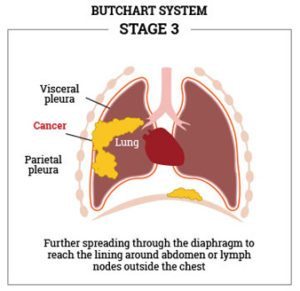
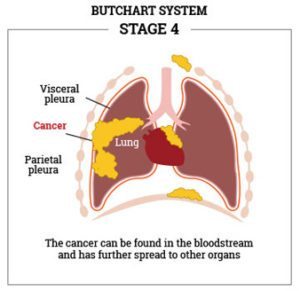
- The TNM System defines Stage III as further spread within the same side of the chest. Stage IV is then the cancer has spread outside the one side of the chest to the other side and to other organs as well.
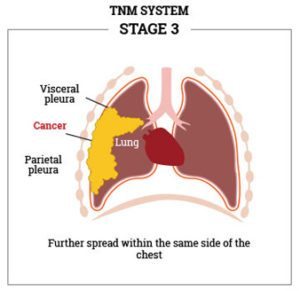
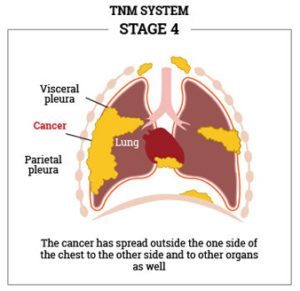
The Brigham System follows these stages:
- Stage I: The cancer has not spread to lymph nodes and can be surgically removed.
- Stage II: Surgery is still possible but the cancer has spread to lymph nodes.
- Stage III: Surgery is no longer possible and the cancer has spread to other parts of the chest, including the heart.
- Stage IV: Surgery is not possible and the cancer has spread to other parts of the body.
Treating Stage I
If this cancer is diagnosed during Stage I, surgery is often a good option because the cancer is localized. Oncologists and thoracic surgeons, who usually make up part of a treatment team, will recommend surgery. If the cancer is only found in one part of the chest lining, that part of the lining and some of the surrounding tissues can be removed. If cancer is found in more than one place, treatment gets more complex and might involve any of the following:
- Pleurectomy surgery to remove the affected pleural and decortication surgery to remove the surface of affected organs like the lung or diaphragm.
- Extrapleural pneumonectomy surgery to remove a diseased lung, some of the membranes that cover the heart (pericardium), diaphragm, and parietal pleura that cover the chest lining.
- Radiation therapy
- Clinical trials, including:
- Anticancer drugs placed directly into the chest after tumors are removed
- Combination of surgery, radiation, and chemotherapy
- New treatments
Clinical Trials for Localized Stage I
Cancer.gov lists several trials testing different approaches to treat Stage I mesothelioma. Current trials are looking at vaccines to treat:
- Several kinds of cancer
- Lung-sparing surgery
- Biomarkers
- Gene therapies
- Drug combinations
Clinical trials are conducted in four phases. Drugs must be approved to progress from one stage to the next. Phases look at safety, side effects, and how useful the treatment works among groups of patients.
Treating Stage II
Stage II is considered to be advanced. Treatment focuses on relieving painful symptoms as much as addressing the cancer itself through surgery, chemotherapy, and radiation. According to cancer.gov, treatment can include any of the following:
- Draining fluid collected inside the chest
- Drug treatment to prevent future fluid buildup (pleurodesis)
- Pleurectomy and decortication surgery to remove cancerous pleura and organ surfaces
- Extrapleural pneumonectomy surgery to remove a cancerous lung, some of the peridcardium (the membrane that covers the heart), and parts of the diaphragm and the parietal pleura membrane that lines the chest
- Surgery to remove cancerous tumors
- Combination of chemotherapy, surgery, and/or radiation therapies to relieve pain and target the target
Surgery is still a good option during Stage II because the cancer has not spread to the abdomen or anywhere below the chest. It is possible to eliminate cancer from the body through aggressive treatment and extensive surgery to remove as much cancerous tissue and organ parts as possible.
Clinical Trials for Stage II
Cancer.gov identifies where patients can apply to participate in different mesothelioma treatments still being studied:
- Different combinations of surgery, radiation, and chemotherapy
- New surgical techniques, including lung-sparing surgery
- Short-term success with higher doses of drugs and/or radiation
- Combination of certain drugs, both approved and under study
- Gene therapies
- New approaches to use radiation therapy
- Vaccines that actually treat the disease, with and without chemotherapy or radiation
- New ways to detect mesothelioma sooner buy checking biomarkers for the disease.
Clinical trials are conducted in four phases, each one with specific approval from the Food and Drug Administration. Each phase studies the treatment’s safety record, side effects, and success in treating the condition.
Treatment for Stage III relies more on pain relief and ensuring the patient is comfortable.
Treatment options are the same as Stage II and, in some cases, repeat treatment is recommended.
Research conducted at the Dana-Farber Cancer Institute has noted the type of cancer cells can influence treatment options and survival during Stage III. Patients whose lymph nodes were untouched by the cancer lived longer, as did those whose cancer cells were epithelial, which form tumors and are easier to target and remove with surgery.
One large, multi state cancer treatment practice stresses that manage side effects and provide supportive care for treating mesothelioma patients. In addition to improving patients’ quality of life, controlling pain helps them remain on treatment schedules that can extend their lives.
How important is side effect management? The cancer treatment practice says neglecting it can be fatal. However, progress in pain management have helped people live with cancer for longer periods of time with a quality of life they find acceptable.
Clinical Trials for Stage III
Patients in Stage III may wish to participate in clinical trials that test new ways to combine different therapies and test new drugs, vaccines, and surgical and radiation techniques. The site cancer.org lets you search for clinical trials by specific types of cancers and cancer stages. There are some new approaches to treat cancer, including mesothelioma, that:
- Grow modified blood cells in laboratories infused into the patient. The blood cells target tumors and attack certain proteins inside cancer cells that will cause tumors to shrink.
- Effect early use of palliative care on patients with Stage III and IV cancers who have not had chemotherapy or radiation therapy for the past 12 months.
- Insert specially designer genes containing cancer-fighting viruses into cancer cells.
- Test photodynamic therapy, an experiential therapy that uses a photosensitizing drug and light to kill cancer cells.
Managing Stage IV
Since managing pain and palliative care is the focus for this stage, surgery may be considered if it will ease pain. Most often, this includes draining fluid that accumulates in body cavities but it may include surgeries to remove diseased organs and linings that contribute to pain. In addition, physicians may prescribe medication to prevent fluid buildup. Penn Medicine, the medical practice affiliated with the University of Pennsylvania, recommends families contact a local hospice program for support that includes managing pain. Many Stage IV cancer patients, including those with mesothelioma, use complementary and alternative medicine to relieve nausea or pain and to manage the stress they are under. Those include mind-body practices such as meditation, yoga, imagery, and hypnosis. Others turn to nutrition and special diets. Discuss using alternative therapies with the treating physician before starting a program.
Clinical Trials for Stage IV
Patients in Stage IV cancer may not be eligible for some trials, particularly those that involve surgery and radiation. However, there are drug trials that accept patients in this stage. The University of New Mexico (UNM) Cancer Care Center describes a drug trial that successfully extended survival and improved the quality of life in some patients with Stage IV pleural mesothelioma. The trial combines two approved chemotherapy drugs, Alimta® (pemetrexed) with Platinol®. UNM reviewed three studies and concluded the drugs extended survival longer than taking Platinol alone. Other benefits included:
- Survival rates were even longer when Vitamin B12 and folic acid were added to the treatment program
- Lung function improved
- Patients experienced less pain
- Patients had “significant and lasting improvement in quality of life” over other severe symptoms including shortness of breath, fatigue, coughing, and anorexia.
Which System is in Wider Use for Mesothelioma Stages?
The TNM system is used most often because it looks at a broader picture of tumors, lymph nodes, and metastasis. It has additional subcategories that look at how the cancer has spread, how pleura have been affected, and whether surgery is likely help.
Why Aren’t There Staging Systems for Other Kinds of Mesothelioma?
Peritoneal, which affects the abdomen, and pericardial, which affects the heart, are even rarer than pleural mesothelioma, already considered a rare cancer. Peritoneal makes up no more than 33 percent of all mesothelioma cases, and pericardial mesothelioma is even rarer, accounting for just one to two percent of cases according to MedGenMed. Mesothelioma is almost always diagnosed in late stages, when symptoms begin to appear. The Better Health Channel in Australia, where cancer rates are among the highest in the world, says that symptoms often appear after the cancer moves into tissues closer to the actual organs or allows fluid to leak into the chest or abdomen.
How Quickly Does the Cancer Cells Metastasize?
Mesothelioma is very unusual in that it can take 15-60 years to actually show symptoms that would prompt patients to seek medical help. Unfortunately, the disease is often diagnosed once it’s actually metastasized or shortly before. Most cases are diagnosed in Stage III or IV. Mesothelioma is considered a very aggressive kind of cancer, probably due to two factors:
- It almost always develops in the chest or abdomen, close to vital organs.
- The kind of tumors seen in mesothelioma patients metastasize quickly.
There are three types of cells seen in mesothelioma: epithelial, sarcomatoid, and biphasic.
About 70 percent of the cases involve epithelial cells, which surround organs and form tumors when mesothelioma invades them. They can only spread through lymph nodes, but once they do, they are in the bloodstream and can reach virtually any part of the body.
Epithelial cells are also found in sarcomatoids, cancerous cells difficult to tell from healthy ones and spread quickly. They are found in up to 20 percent of all mesothelioma cases.
Biphasic cells are seen in up to 35 percent of patients and most often in pleural mesothelioma. They include elements of the other two cells and are tricky to locate and treat. Cancer cannot be detected at the cellular level. It’s only possible when the cells band together to form cysts or tumors. Tumors are the primary way cancer spreads through the body.
In mesothelioma, symptoms don’t even show until tumors are pretty well established, and many symptoms mimic head colds or upset stomachs most people assume will go away in a few days. Recent research published by On Cancer, a newsletter published by Memorial Sloan Kettering Cancer Center, explains how some cancer cells resist the body’s natural defenses.
For example, the blood-brain barrier is packed with a protein that triggers a self-destruct mechanism in most cancer cells—showing a hopeful new area for research. But a few cells produce a protein that lets them attach to blood vessel walls and thrive.
